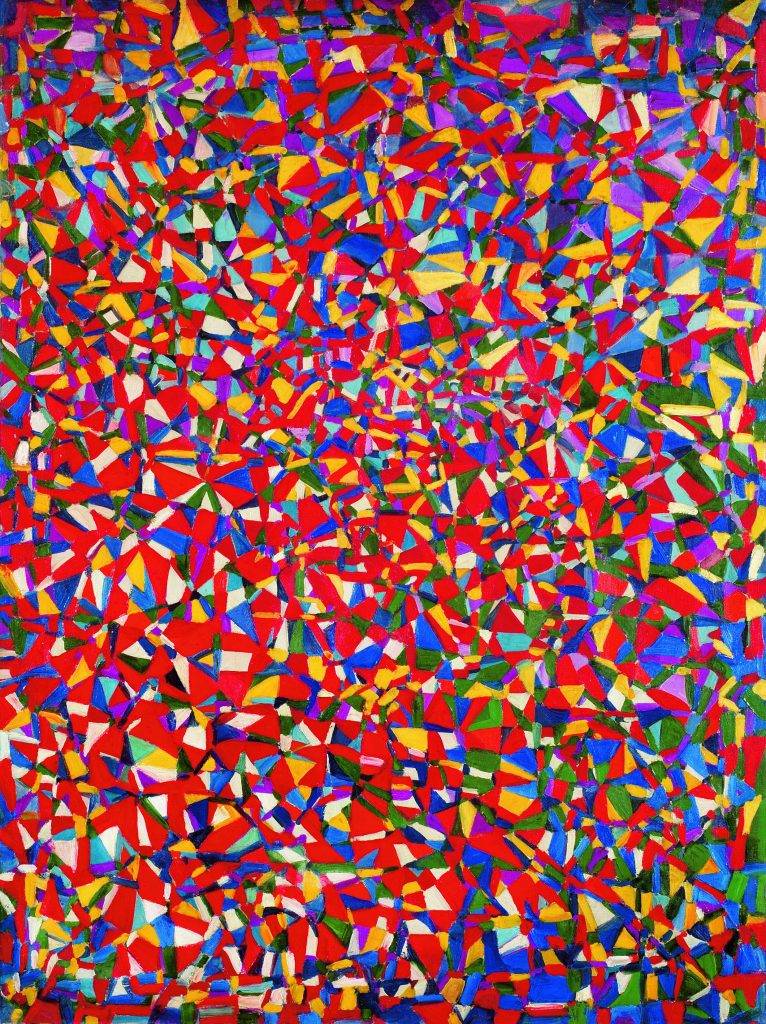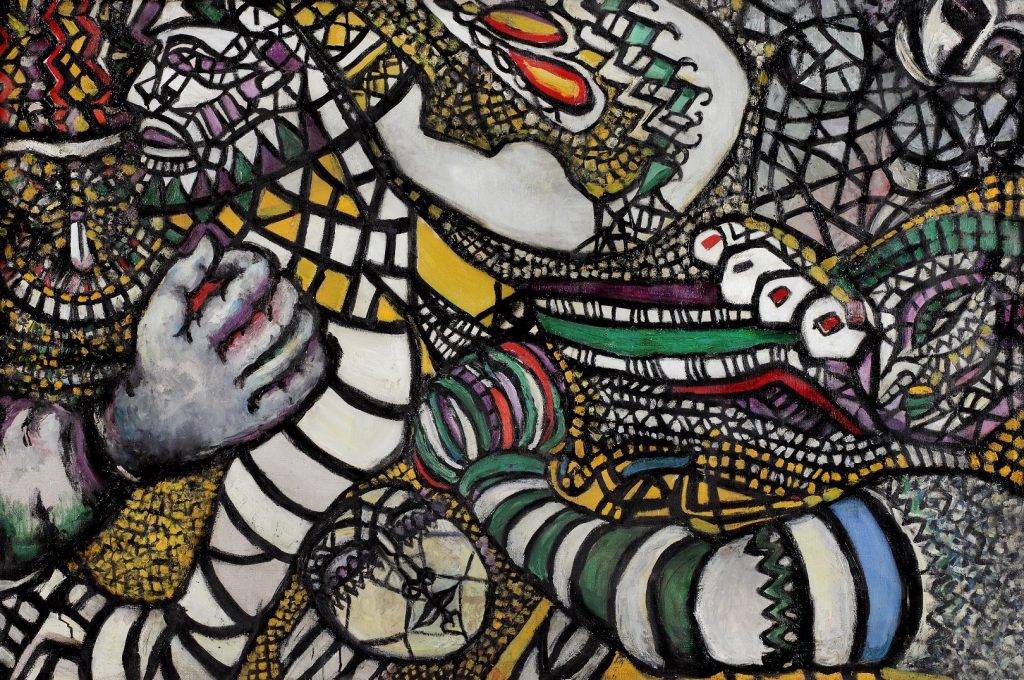‘I am the descendant of four civilisations. In my self-portrait, the hand is Persian, the dress is Byzantine, the face is Cretan, and the eyes Oriental, but I was not aware of this as I was painting it.’
The current retrospective of the work of Princess Fahrelnissa Zeid (1901 – 1991) at London’s Tate Modern tells the story of one of Turkey’s most remarkable women. Born into a prominent family in Ottoman Turkey, she was educated in Istanbul and Paris, and lived the life of not only a princess, but also a diplomat’s wife and painter, in Baghdad, Berlin, Paris, London, and Amman. Until now, Zeid has largely been neglected in the West; but, in the first exhibition of its kind in Britain, with all but one of the paintings having been loaned from outside the country, the Tate Modern show is shedding light on her diverse oeuvre.
The exhibition moves chronologically, following Zeid’s extraordinary life in colour and paint from her birth in Istanbul to her time in Amman, where she is widely recognised for transforming the reception towards art there. It begins with a watercolour portrait by Zeid of her grandmother, composed at just fourteen years of age. Alongside it are details of Zeid’s upbringing in Ottoman Turkey, where she joined the Academy of Fine Arts for Women at just nineteen, and soon after married her first husband, İzzet Melih Devrim, a novelist whose career allowed Zeid to travel and expose herself to European galleries and museums, as well as enroll in an art school in Paris.

The works marking the beginning of Zeid’s career are comprised of narrative scenes replete with figures in thick black outlines. Turkish Bath brings to mind the odalisques favoured by French Orientalists like Ingres, with its portrayal of nude women in a blue oasis, grouped together and enjoying themselves. They appear as though they are oblivious to the painter’s gaze, and are not, as in many of the works of the Orientalist painters, shown as sexual objects, resulting in a sort of subversion of Western stereotypes. Also on display in the introductory section are Zeid’s sketchbooks, which are not only full of preparatory sketches, but also fully constructed paintings and notes, offering a glimpse inside her artistic process. Audiences are also shown catalogues from shows that took place in Paris, New York, and London.
Beyond Zeid’s initial figurative pieces, the large abstract canvases the artist is renowned for are highlighted in another section of the exhibition. Although human forms can be seen in the 1943 piece Third Class Passengers, they become more and more amorphous towards the end of the decade. In Three Ways of Living (War), the canvas is divided into three island forms by large bubbles of what looks like smoke, with dark black birds (or perhaps war planes), swooping into the bottom right-hand corner, arriving to disturb the piece. The painting details a unique view of the Second World War, in which Zeid played the role of a diplomat’s wife following her marriage to her second husband, Prince Zeid bin Al Hussein, brother to the King of Iraq and the country’s first ambassador to Germany. Following the outbreak of the War, the prince was recalled to Baghdad and later became the ambassador to Britain, giving Zeid the opportunity to live between London and Paris and mingle with the avant-garde artists there.

One of the most poignant pieces in the exhibition is perhaps 1947’s Fight Against Abstraction, which documents Zeid’s struggle to embrace the trend towards abstraction that was gaining popularity in Europe at the time. Amongst dozens of shapes that have been tessellated together, one can make out a number of faces and arms. The most prominent part of the painting can be seen in a grey fist moving in from the left of the painting. The limb is the only part of the image that has not been fragmented, and it appears to be punching the rest of the painting. Zeid’s technique of breaking up the forms within her works into smaller pieces is similar to that of Byzantine mosaics, and others have also likened it to the process of Persian carpet weaving.
I am the descendant of four civilisations. In my self-portrait, the hand is Persian, the dress is Byzantine, the face is Cretan, and the eyes Oriental, but I was not aware of this as I was painting it
The focal point of the exhibition is comprised of a series of several large abstract canvases executed during a period of depression in the forties and fifties. The process of fragmentation that begins in Fight Against Abstraction is carried through here in images composed of dozens upon dozens of tiny splinters of bright colours, which are either dispersed with heavy black or bright white. In My Hell (1954), a five-metre long work, shades of yellow and black seem to serve as a sort of warning, while danger is evoked through the use of hot, fiery red. As well, the red and yellow edges of the painting draw the viewers’ attention into a vortex of black, grey, and white in the centre, in which colour is entirely absent. The Arena of the Sun (1954), on the other hand, with its sprinklings of yellows, blues, and greens interspersed with tiny shards of white, presents an emotional contrast, moving away from darkness towards light.

In 1958, a military coup in Iraq saw the entire royal Hashemite family in Baghdad assassinated. Prince Zeid Al-Hussein and Princess Zeid narrowly escaped, after having just twenty-four hours to vacate the Iraqi Embassy in London. Afterwards, on holiday in Ischia, Italy, the artist painted a series of watercolours strikingly different to her other works. In these paintings, Zeid’s strong defining outlines have been done away with; her compositions are softer, and appear as if in a haze.
Following the coup, Zeid and her husband had no choice but to move into a small apartment in London, where she would cook her first meal at the age of fifty-seven. Remnants from this dinner serve as the opening to the show’s final gallery. A turkey bone, painted in black stripes, can be found playing the role of a swimming dinosaur, floating in the air upon the turning pedestal on which it has been exhibited. The artist nearly threw the bones away, but refrained from doing so after being struck by their shapes. They later served as inspiration for a series of bone sculptures encased in coloured resin, which she called Paleokrystalos (‘ancient crystals’ in Greek). They appear like crystalised sugar, with the sharp edges of bone juxtaposed with the brightly coloured green and orange resin recalling Zeid’s Byzantine-inspired abstract canvases.

From figurative to abstraction, and to portraiture again, a series of portraits surround Zeid’s preserved bones. The images were painted in Amman towards the end of Zeid’s life, where she moved following her husband’s death in 1975 to be closer to her son Prince Raad bin Zeid. The figures on these large canvases have large eyes and full eyebrows, and have mostly been painted from the neck upwards. During this period Zeid also set up an art school, where she taught women to paint. While she taught her students abstraction, she moved away from it herself, favouring portraiture instead. ‘I place the model a distance away from me, so I cannot see the details to gain a general view … [of] the presence of the person, and perhaps the soul’, she once said. ‘I don’t think there’s a big difference between a portrait and an abstract [painting] … because it is not a photo. It is the soul.’
The images of the artist’s friends and relatives resemble exaggerated caricatures, their features enlarged and inflated. Instead of dividing her sitters into small pieces, she amplifies them, making them larger than life, and matching the scale of her abstract canvases. And, while the portraits are identifiable and clearly correspond to actual individuals, they are still abstractions in the sense that the figures have been augmented and distorted.
The retrospective at Tate Modern cements Zeid as not only a great Turkish artist, but also one of the twentieth century in general. ‘In the beginning, people did not take her seriously because she was a woman. She was a salmon swimming upstream’, says Raad bin Zeid in a film about his mother playing on a loop in a side gallery of the exhibition. ‘She was not French – she was Muslim, she was a princess’, remembers a former pupil, going on to say that, ‘she was generous and she loved life, so colourful in so many ways’. Indeed, it would be difficult to deny that Zeid lived a remarkable life, spanning countries, cultures, and a vast array of life-changing experiences. That she was also an outstanding artist only makes it even more extraordinary.
Tate Modern’s Fahrelnissa Zeid retrospective runs through October 8, 2017.
This article was written by Lizzy Vartanian Collier and originally published on REORIENT






